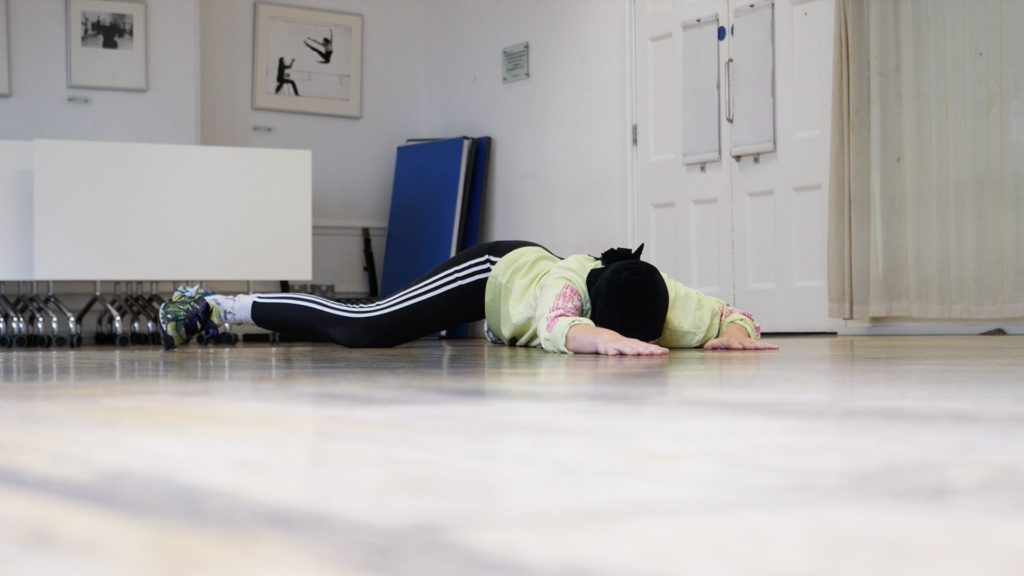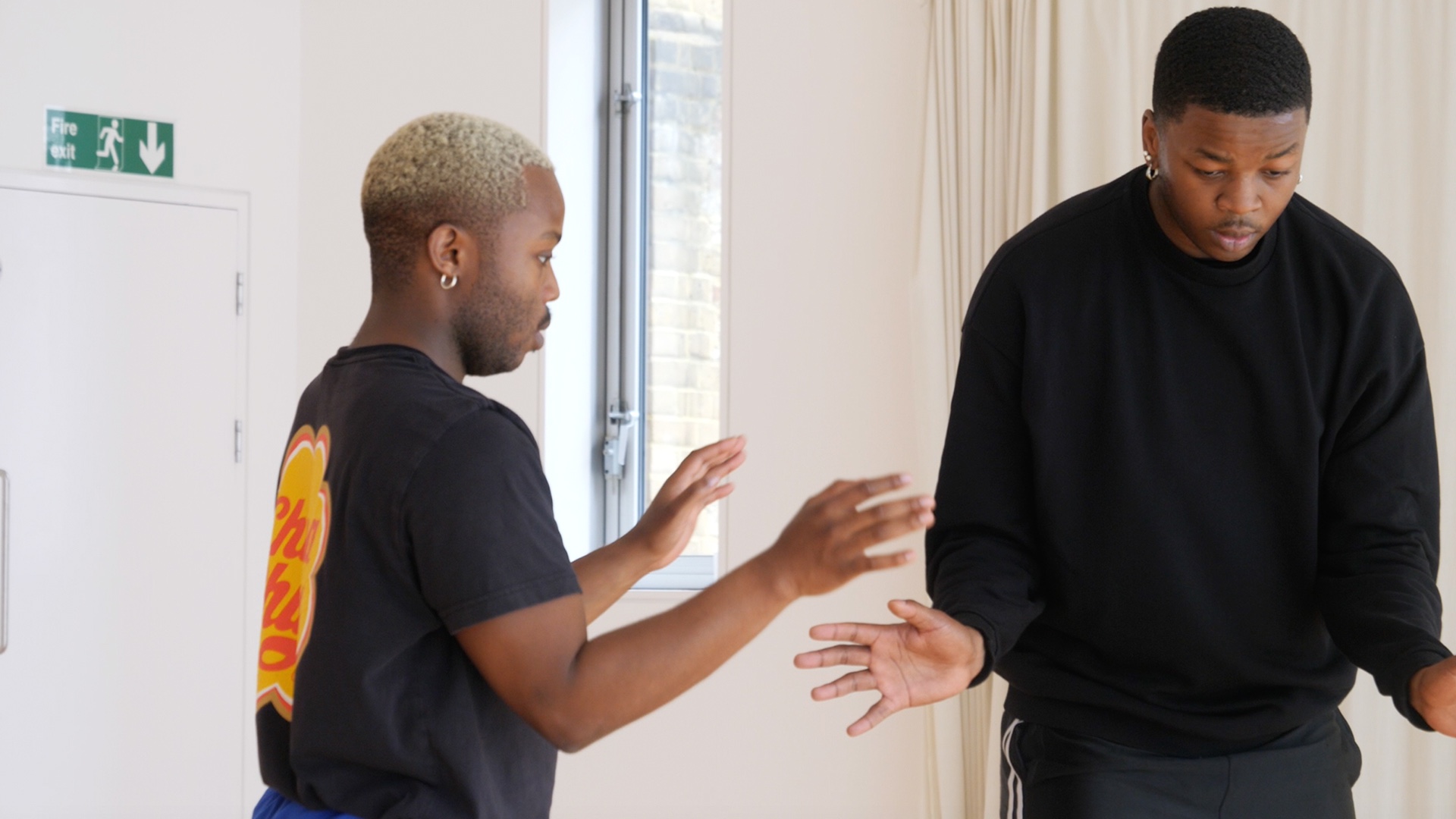Words by Qiao Lin Tan.
In early September, The Place’s Choreodrome residency artists performed in Touch Wood, a work-in-progress showcase that marks the end of Choreodrome season. Each artist was allowed 10 minutes of stage time, and most of what was shown were incomplete, partial or condensed versions of the artists’ visions.
As a writer, approaching work-in-progress showings tends to be quite tricky and one must be constantly reminded that the onstage action consists of un-contextualised fragments and not fully realised ideas. How does someone write about an incomplete work in a constructive manner? Are the ambiguous, incomplete bits of onstage action unclear because the rest of the choreography was not shown, or because it simply is unclear? Is this review-like format even the best mode of writing for a work-in-progress showing such as this?
Day 1
Chaldon Williams’s offering stemmed from street dance styles as four dancers – three men and one woman – explode onto the space. There were a few moments that popped out, and one of it was the somewhat ambiguous idea of gaze and spectatorship. One of the men sat on the floor downstage with his back to the audience and gazed at the woman as she performed an indulgent solo featuring mesmerising arms and a supple upper body. This relationship was thrown into disarray when the woman later approached the man and helped him up like one might an elderly person, leaving me unsure of the exchange.

The second showing of the night was by Louise Ahl, who appeared in a colourful unitard and trainers. The work was a close-up study of movement, but in the style of an irreverent, comedic wildlife documentary delivered through operatic vocalisations. The sung text, like a David Attenborough commentary, described the “subject’s” (aka Ahl’s) animal-like actions – different modes of crawling and moving along the ground. Despite the humour (which was extremely effective), I was touched by the seriousness (an opera is as “serious” a music genre you can get) afforded to the smallest creature’s most mundane movements. Ahl’s work was intriguing as well in the relationship between the text/sound and the movement. Was the voice-over a post-humous description or pre-emptive instruction? The singing was done by her voice as well, so the meta-loop was mind-boggling.
Sivan Rubinstein and her partner performed in the penultimate work of the evening, featuring a repetitive yet entrancing circling of arms. There was something aqueous about the work – the atmospheric music was reminiscent of ocean documentaries and the swimming/diving arm motions for at least half of the showing cemented that. The duo performed these movements in a unison that seemed spontaneous, responding to each other in the moment, falling slightly out of sync at times but picking back up. The unison and repetition was wonderful to watch until it wasn’t and became, well, repetitive, and I was interested to find out where they would go from there.
Finally, Seke Chimutengwende’s quartet performed a condensed 10 minute version of their 40 minute long improvisation score. Perhaps it is a simplification to say that what I watched was just dance, but the work seemed to return to basic elements of dance – entrances and exits, pauses and moving, different speeds. It was “just dancing” in a way that was extremely mesmerising to watch, because the pleasure came from witnessing people make decisions onstage. It was only at the end where movement became more weighted in meaning – Chimutengwende, now alone onstage, looked around the space, as if discovering or remembering something. Or perhaps trying to find something? Either way, the space suddenly became tangible and there, the very place in which all dancing happens.

Day 2
The second night opened with Ching Ying Chien’s work, a 10-minute segment of what was already a 40-minute piece. A man with a crocodile head sat at a dining table, sawed off his head and ate it with a fork and knife. Chien emerged from under the table and offered him champagne. There were sections where Chien violently flung herself on the ground, the man played a stringed instrument, then physically restricted Chien’s struggling body. And then they kissed, and then they fought. Amongst all this randomness and chaos, they shared an intimate embrace and waltz, a moment of calm in the eye of a hurricane. The work was an exploration of dream states, which was where the absurdity and randomness stemmed from, but I felt that the logic of the dream went over my head. Which was to be expected since we were only shown the middle section of the work.
The second work, by Bakani Pick-Up, was an improvisation score performed by a trio of black men and women. Bakani prefaced his sharing with an introduction to his research, which was about how improvisatory practices could shape (re)presentations of Blackness. The stand out element of the work to me was the deliberate nature of the gaze. The purposeful way in which the dancers gazed at each other as they walked around the space seemed to complicate the idea of a (White) objectifying gaze on the Black body. Gaze here was used to acknowledge one another and hold space – there were multiple moments where two dancers observed on the side as the third turned their focus inward and danced without reservations. The only times where the performers acknowledged the spectating audience was when Pick-Up approached a microphone stand and asked “What is freedom to you?”. The rejection of the spectating (objectifying) audience’s gaze in favour of the looking between performers/comrades/equals gained an additional significance when one considered the performer’s Black identity.
The third work was by Bar Groisman, featuring four women in ‘period-style’ Edwardian dresses. At first, they displayed patriarchal versions of womanhood – fake smiles, hands clasped demurely as they took teeny steps. Glimpses of “undesirable” traits started to trickle in, such as posing seductively, assuming birthing and sex positions, smoking. The work then continued in a “rage against the machine” manner, with the performers stripping off articles of clothing, charging swiftly across the stage and mocking “desirable” womanly traits. The feminine rage was palpable, but what surprised me was the reveal at the end that the work was specifically about periods. The experience of periods seemed to be conflated with “woman”, which I do not think is necessarily the case, but gender politics is also an incredibly nuanced and complicated topic that is constantly shifting.
The final work of Touch Wood was by Simeon Qsyea, and audience members were invited to experience the piece onstage. A group of young dancers exploded into the space, dynamic and sassy and powerful. The work felt like a stereotypical street jazz/lyrical competition performance, with the twist of having audiences amongst the dancers. The negotiation between the dancers’ and the audience’s bodies in the space required an impressive amount of spatial awareness and control. The proximity and danger of it all created an interesting tension and indeed, the most engaging moments for me were when the dancers established relationships with audience members (which were, disappointingly, quite few). Whilst I enjoyed the explosion of dancing and the danger it brought, I yearned for the choreography to make use of the audiences in the space – surely it could be more than just supplanting audience members closer to the performers.
The importance of Touch Wood is that it is a presentation of rough drafts. It is okay if the work is not perfect, because the programme’s objective is not to commission a final work but to support artists in their research activities. Initiatives like this are essential in an arts ecosystem where product is valued over process. Artists need to be supported in researching, trying, maybe failing, so that the boundaries can be tried and tested. This playful, experimental spirit is perfectly encapsulated in the title of Touch Wood – ‘We’ll see how it goes! Fingers crossed!’
